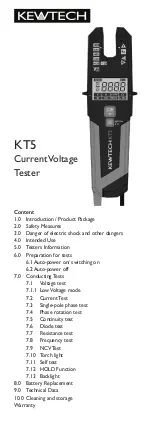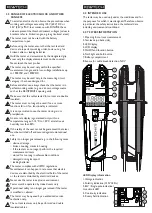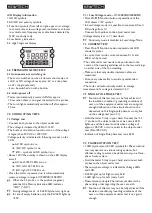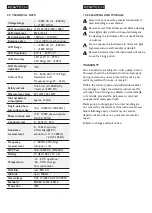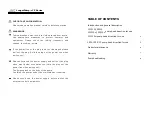
References marked on instrument or in instruction
manual:
Warning of a potential danger, follow with instruction
manual.
Reference! Please use utmost attention.
Caution! Dangerous voltage. Danger of electrical
shock.
Continuous double or reinforced insulation category II
IEC 536 / DIN EN 61140.
Equipment for working under live voltage.
Conformity symbol, the instrument complies with the
valid directives. It complies with the EMV Directive
(2014/30/EU), Standard EN 61326-1 are fulfilled. It also
complies with the Low Voltage Directive (2014/35/EU),
Standard EN61243-3:2014 is fulfilled.
UK Conformity compliance mark
Tester complies with the standard
(2012/19/EU) WEEE.
The instruction manual contains information
and references, necessary for safe operation and
maintenance of the tester.
Prior to using the tester (commissioning/ assembly)
the user is kindly requested to thoroughly read the
instruction manual and comply with it in all sections.
Failure to read the tester manual or to comply with
the warnings and references contained herein can
result in serious bodily injury or tester damage.
The respective accident prevention regulations
established by the professional associations are to be
strictly enforced at all times.
Voltage tester is not a measurement device, it is only
allowed to use for testing purposes.
1.0 INTRODUCTION / PRODUCT PACKAGE
The KT5 is a universal tester for voltage, current, continuity
and rotary field testing with various secondary features.
It complies with the standard for two pole voltage testers
EN61243-3:2014.
The KT5 is characterized by the following features:
• Designed to meet international safety standards
EN61243-3:2014
• Measurement Category CAT IV / 600 V Measurement
Category CAT III / 1000 V
• AC and DC voltage test up to 1000 V with LEDs
• Current test up to 200 AC
• AC voltage test up to 1000 V and DC voltage test up to
1500 V with LCD
• Cable break tests by Non Contact Voltage detection
• Polarity indication
• Single-pole phase test
• Phase rotation test and Continuity test
• Resistance measurement
• Frequency measurement
• Vibration motor
• Auto-power ON / OFF
• Torch light and IP64 protection
After unpacking, check that the instrument is
undamaged.
The product package comprises:
1 pc Tester KT5
2 pcs batteries 1.5V, IEC, LR03 (AAA)
1 pc operating instructions
2.0 SAFETY MEASURES
The testers have been constructed and tested in
accordance with the safety regulations for voltage
testers and have left the factory in a safe and perfect
condition.
The operating instructions contain information and
references required for safe operation and use of
the tester. Before using the tester, read the operating
instructions carefully and follow them in all respects.
Depending on the internal impedance of the voltage
tester there will be a different capability of indicating
the presence or absence of operating voltage in case
of the presence of interference voltage.
A voltage tester of relatively low internal impedance,
compared to the reference value of 100 k�, will not
indicate all interference voltages having an original
voltage value above the ELV level. When in contact
with the parts to be tested, the voltage tester may
discharge temporarily the interference voltage to a
level below the ELV, but it will be back to the original
value when the voltage tester is removed.
When the indication “voltage present” does not
appear, it is highly recommended installing earthing
equipment before work.
A voltage tester of relatively high internal impedance,
compared to the reference value of 100 k�, may not
permit to clearly indicate the absence of operating
voltage in case of presence of interference voltage.
When the indication “voltage present” appears on
a part that is expected to be disconnected of the
installation, it is highly recommended confirming by
another means (e.g. use of an adequate voltage tester,
visual check of the disconnecting point of the electric
circuit, etc.) that there is no operating voltage on the
part to be tested and to conclude that the voltage
indicated by the voltage detector is an interference
voltage.
A voltage tester declaring two values of internal
impedance has passed a performance test of
managing interference voltages and is (within
technical limits) able to distinguish operating voltage
from interference voltage and has a means to directly
or indirectly indicate which type of voltage is present.

